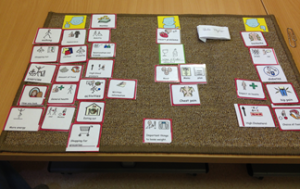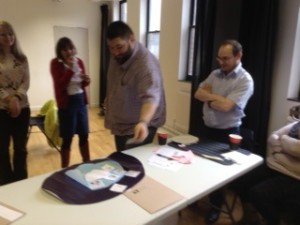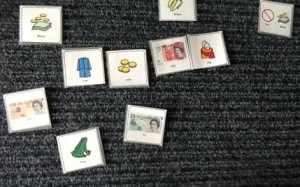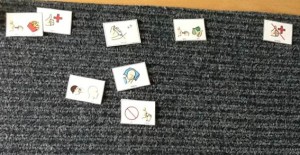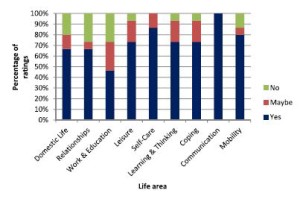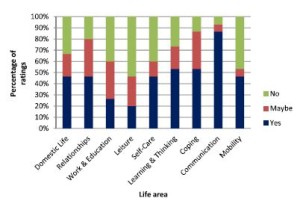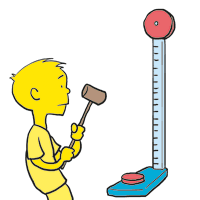Many thanks to Shirley Rush Health Facilitator at Belfast Health and Social Care Trust for this great blog about using TM as a ‘weigh to health’.
Following my Talking Mats (TM) training I had the opportunity, as a health facilitator, to use TM in an adapted ‘Weigh to Health’ course. This course encouraged people with learning disabilities to make small changes to their lifestyle and to educate them on the effects of obesity and their health.
Prior to commencing the group work we met with each person and completed a Talking Mat. The topic was to explore “Important things to lose weight”, we used a wide range of symbols and included physical activity, health conditions and appearance. Clients also requested additional symbols were added including alcohol, cycling and mood, which made the mat individual to them.
A photograph was taken of the completed TM to act as a record of what was important to them. On completion of the group the TM was repeated with each person using the same topic and symbols and the mat was again photographed. When we compared the TMs it showed that all the client’s knowledge and understanding of the effects of obesity and the health benefits associated with weight loss had increased.
“it done me good, helped me to lose weight by talking about my health and the need to lose weight to look after my heart”
The use of the talking mat was a valuable resource, it allowed each client to make an informed choice about participating in the group work. One client said he felt he had been listened too and “it done me good, helped me to lose weight by talking about my health and the need to lose weight to look after my heart”. By using TM in this way we have been able to use this information to demonstrate outcomes and it shows the information was presented at a level of understanding suitable for the client group. On an easy read questionnaire about the course all the clients agreed that doing the TM was useful, one person wrote “loved doing the mat”.
If you want to get more information from Shirley contact her at Shirley.rush@belfasttrust.hscni.ne
We have received a number of requests to create a guide to adding your own images and creating submats with Digital Talking Mats and this blog will show you how.
One of the features of Talking Mats is that we have developed a number of different symbol resources based on our research and clinical practice which cover a wide range of topics.
However, sometimes you may want to personalise what is being communicated about by adding your own images. You may also want to create a submat to explore an existing topic in more detail or you may want to create a completely new topic. In our training courses we explain how to do this when using the original Talking Mats.
However more and more people are now using the digital version of Talking Mats. In a previous blog we described how to add your own photos to the Digital Talking Mats.
We have now made a guide to help those who have the digital version to both add their own images and to create a submat with an example of a sub-mat with the topic “office”.
Download the following pdf to find out how to do it. dtm-a-guide-how-to-add-photos
We would love to hear any stories about making your own digital submats
This blog describes the foundation Talking Mats course we ran for members of the National Involvement Network. Following the seminars and the work to design a Charter for Involvement ‘Taking Part Talking Mat’ described in a previous blog , 16 people attended our course run over three days with about a month between each session. The participants were 8 NIN members who all had a worker to support them as a learning partner. Their role was to assist with embedding the knowledge gained, and the implementation of the pilot ‘Taking Part Talking Mat’. The learning partners were equal course participants, and expected to complete all course activities e.g. make a video of themselves carrying out a Talking Mat
In adapting the foundation Talking Mats course we learnt lots! Here is a summary of key learning.
- That we had a great group of people who were keen to learn and develop their communication practice to become Talking Mats interviewers, or as we call them in Talking Mats ‘the listener’ ( as they are listening to someone’s views). They appeared to really enjoy the learning experience and were enthusiastic, embracing all tasks including making a video of themselves using Talking Mats with someone in their organisation. In Talking Mats we call the person doing the mat ‘the thinker’.
- That it was really important for us as trainers to focus on key information, not all information so as not to overload
- That movement helped learning. It was good to design activities with some potential for movement so that people were not sitting too long and that they could get up and stretch.
For example, on the Talking Mats foundation course there is an activity that thinks about abstract and concrete language. We adapted this by using cut out coloured circles and got participants to think about the language load of a particular concept and place the symbol concept in the relevant circle.
- Teaching the principles of Talking Mats and getting the participants to follow the rules e.g asking open questions, introducing blanks, the check and change stage was relatively easy. What was more problematic was supporting a listener to be flexible and person centred in the way they introduced an concept . Often it is important to give a relevant example to support a thinker’s understanding and our listeners struggled with that. To overcome this, we wrote specific examples on the back of the cards and designed some activities to give time to practice. Repetition of learning was important
- A detailed script helped, including what to say to introduce the Talking Mat
- That you needed to pay particular attention to the quieter members of the group –coffee breaks proved to be a useful time to catch up on their thoughts and feelings
- The role of the learning partner is critical. We were very fortunate in our partners. They were natural enablers and it showed. We relied on partners sharing a set of values, and believing that people with learning disabilities could learn and be a key member of the pilot project.. One person did not complete the project maybe because she felt uncomfortable. It made us realise if we were to do this again we should be explicit about values and the roles of the learning partner from the outset
- That the recording of interviews needs support, and it was key that there were was both a NIN member and a learning partner to enable that to happen
- That our partnership with ARC Scotland was key as they provided individual follow up advice to each of the organisations involved and provided a source of learning reinforcement , observation and support to each of the NIN members and their learning partner. They were also able to feedback to the course organisers about any areas of difficulty that needed further attention and input
- That Talking Mats empowers both the thinker and the listener. It gives a structure to make a conversation flow. The training itself not only gave the NIN members who attended a tool to communicate with others about how they feel, but also seems to have had a positive knock on effect on their confidence and we hope that continues.
We are incredibly proud of our cohort of trained Talking Mats listeners. As part of the project they have been interviewing other service users in their organisations about 2 aspects of the Charter for Involvement –‘independence’ and ‘being involved in their community’ – ( 2 abstract concepts, as the NIN listeners will tell you). Not only has this included more people in service evaluation but has led to making changes that are improving lives.
For example
One woman was no longer being taken to church and she is now going and starting to be part of a local church community
One man who everyone thought was doing really well living on his own expressed a view that he was feeling lonely, He is now being supported to identify if there are enough people interested to start a local group.
Two videos were made by the group the first shows what they found out using their Talking Mats tool
We are delighted to have been one of 15 new projects awarded funding from The Health and Social Care Alliance Scotland.
The ALLIANCE, in partnership with the Scottish Government have announced the funding in a second phase of the Transforming Self Management in Scotland Fund.
Announcing the newly funded projects at the Self Management Awards, Minister for Public Health and Sport, Aileen Campbell MSP, said
‘This new phase of projects supported through the Transforming Self Management in Scotland Fund will be working to address some of the major challenges we face across health and social care, head on. It’s vitally important that we continue to recognise how lives can be transformed when people are supported to live well, on their own terms, with whatever long-term conditions they have.’
The projects currently funded by the Transforming Self Management in Scotland Fund support a broad range of self management activities and age groups in wide range of locations across Scotland, from the Highlands to the Borders. All 15 new projects, along with the 23 existing projects strongly contribute to the Clinical Strategy for Scotland and demonstrate clear links to the Fund’s ethos of transforming self management in Scotland through person centred, co-productive approaches within their communities.
The Grant Allocation Panel, made up of members of Government, third sector organisations, people with lived experience, NHS and from academia, were impressed with the high standard of applications received to the Fund in the first round of funding which closed in December 2015. Due to the high number of excellent applications received the panel chose to take a small number of applications forward to a second phase of assessment of which 15 were successful. This now allocates £7million of the available £10million until 2021, so the Panel have taken the decision not to open a new round of Funding this year. The Fund will likely open to new applications in October 2017.
The 15 funded organisations are as follows:
• Bipolar Scotland
• Grampian Opportunities
• Highland Third Sector Interface
• LGBT Health and Wellbeing
• Lomond and Argyll Advocacy Service
• Nari Kallyan Shangho
• Pain Concern
• Plantation Productions
• Realize Your Potential CIC
• Scottish Council on Deafness
• Scottish Recovery Network
• Spina Bifida and Hydrocephalus Scotland
• Talking Mats
• The Haven
• Volunteer Development East Lothian
In our Talking Mats project, we want to empower people with a range of long term conditions (LTC), with and without additional communication difficulties, to manage their own health and well-being by using Digital Talking Mats (DTM). Digital Talking Mats will be used in our project to support people to:
1. reflect and describe the issues which affect their quality of life (not just those perceived by carers and/or professionals) and which matter most
2. ensure that their specific concerns are acknowledged and dealt with and not just assumed to be caused by their long term condition
3. recognise and develop their own strengths and abilities
4. share their insights relating to their health and social care in an easily accessible and recordable manner across all settings
5. own and implement self-management solutions
6. evaluate their progress and the long term impact of using DTM for their self-management
7. increase communication with health and social care professionals
Currently the DTM is used predominantly by professionals but its intuitive design means that there is great untapped potential for it to be used by individuals with long term conditions as a self-management tool both in their own homes and in health and social care settings.
We will work with 30 people with different long term conditions in Scotland – 10 people with dementia, 10 people with learning disability and 10 people with stroke. We will visit each person in their own homes to show them how to use the DTM, to provide ongoing support and to evaluate how they are managing their health and well-being.
Anyone interested in further information about this project should contact: info@talkingmats.com or telephone 01786 479511
Exploring sibling attitudes towards participation when the younger sibling has a severe speech and language disability
We were delighted to receive this publication from a friend and colleague, Prof Juan Bornman from Pretoria in South Africa. It reports on a study carried out with 27 typically developing children who have a younger sibling with a severe speech and language disability. Juan and her colleagues used Talking Mats to carried out an adapted structured interview to find out the views of these children on four everyday life situations identified by the WHO-ICF-CY (World Health Organisation’s International Classification of Functioning, Disability and Health, Children and Youth Version).
The four topics were:
Communication
Domestic life
Interpersonal interaction and relationships
Major life areas.
The findings showed that the children were ‘most positive towards participation in play activities with their sibling with a disability. They were also positive towards participation in household tasks. They were less positive towards communication participation and least positive about participation in interpersonal relationships’.
The following example is taken from Juan’s publication.
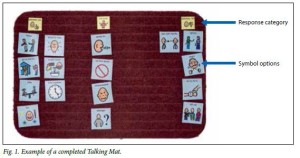
The article’s reference is:
Exploring sibling attitudes towards participation when the younger sibling has a severe speech and language disability. M Hansen, M Harty, J Bornman South African Journal of Child Health 2016 Vol. 10 No. 1
To read the full publication with details of the methods used and the results click here sibling-attitudes-2016
Many thanks to Ruth Spilman, Senior Speech and Language Therapist, for this great blog about how she uses Talking Mats for Capacity Assessments with People with ASD/LD
I am a speech and language therapist (SLT) working in a residential provision for young people with autism spectrum disorder, learning disabilities and other co-occurring difficulties. We support young people from 7 up to the age of 20. Many of the young people are in a ‘grey area’ with a view to capacity assessments, including those aged 16-18. We support many capacity assessments, including deputy-ship for finances and care, health and welfare, as well as more individualised capacity assessments around restrictions in the environment, consent to medical interventions and making decisions about the future.
A large part of the way we support these capacity assessments is by using Talking Mats, which support people with autism who generally prefer to think about things visually. The young people are encouraged to use Talking Mats in their everyday communication, such as evaluating activities, lessons and therapy sessions to develop their skills, as well as during direct Speech and Language Therapy work. If a young person has proven their competence using a Talking Mat, we can then move on to supporting capacity assessments. As part of the process, the SLT would break down the concepts needed to be understood to identify if the individual has capacity or not. For example with finances, do they know what money is? can they organise things that are expensive and cheap? can they put items in a scale of least to most expensive? This would all be done using a Talking Mat, then followed up if they achieved this task with a range of further activities. A Talking Mat can then support activities to evidence their understanding or lack of, while also giving a young person all practicable help to communicate.
See below two examples of a young person thinking about 1) money to support their finances, and 2) things that are healthy or not.
Talking mats are used for a range of different skills and assessments in the provision I work in, but their use for capacity assessment gives the young people the most practicable support with communication and allows for clear evidence of the person’s understanding of the concepts involved. In addition to the range of items mentioned above, we have have also discussed tattoos, physical intervention and behaviour support strategies, having a lock on an individual’s bedroom door, and understanding of fantasy and reality.
Talking Mats has proved to be a truly simple but brilliant and useful tool.
Ruth Spilman, Senior Speech and Language Therapist, Specialist services in education
The Cambian Group, Dorset, BH19 1PR www.cambiangroup.com
We were delighted to receive this excellent poster from Lora Franceschi who used Talking Mats and the Visual CARE Measure to facilitate patient feedback in a rehab team. Lora works with the Speech and Language Therapy Rehab Team at Queen Elizabeth University Hospital in Glasgow.
The team combined the Visual CARE Measure with the Talking Mats technique to fulfil the following aims:
- Obtain the views of patients (and their carers) on how empathic and patient centred the SLT had been during their inpatient rehab stay
- Establish if the Talking Mats activity could facilitate feedback from patients with moderate-severe communication difficulties
- Determine the time and resource implications in obtaining patient feedback using the above method
- Ascertain whether this format could be rolled out across other SLT teams within Greater Glasgow and Clyde
These aims were all fulfilled and they concluded that this approach could be replicated with other teams and used as a means to gain feedback from patients with communication difficulties.
Click here to see the full poster with their results 2016 QEUH VCM and TM. We think this is such an excellent poster that we have printed it out and put it on the wall in the Talking Mats Office.
You can do the same!
To get copies of the full report please contact Lora at Lora.Franceschi@ggc.scot.nhs.uk
We have been exploring how Talking Mats can be used as a tool to support business – both a framework for interviews and appraisals. Because it supports reflection, it is an ideal framework for employers to use with job candidates.
The recruitment process is time consuming for organisations, and any errors at this stage can be costly for teams. When I applied for the post of associate with Talking Mats I wasn’t surprised that the actual interview was engaging and different from any other interview experience.
The first part was for the candidates to teach the interview panel a skill, in 5 minutes. As a speech and language therapist this made a lot of sense to me, as teaching people a skill is more empowering than merely sharing your knowledge.
The second stage of the interview was using a Talking Mat to consider my levels of confidence in relation to aspects of the post.
Having used Talking Mats with children and parents in my clinical work, I wasn’t used to being ‘on the other side of the mat’, and experienced first-hand the positive aspects.
Firstly, it gives the interviewee permission to break eye contact. This immediately takes away the pressure of non-verbal feedback from the panel e.g. if one of the panel is smiling encouragingly, it is tempting to focus on that one person and possibly say too much. The focus being on the cards and the actual mat can reduce anxiety, supporting people to clearly express their views.
Another aspect of Talking Mats is that the person interviewing, hands to the candidate a picture card on one aspect of the topic e.g. knowledge and skills.
The multi sensory aspect i.e. auditory , tactile and visual, supports the candidate to focus on this one concept and share his or her reflection.
The conversation is then built up and captured on an actual mat and the candidate has the opportunity to move the options on the scale as the conversation progresses.
Talking Mats as a communication tool maximises the capacity of individuals to say what matters to them. How many people leave an interview feeling they didn’t say what they wanted to?
P.S. I got the job!
We are very grateful to Lauren Pettit and her colleagues from Pretoria, South Africa for sending us their published paper on a recent research project which used Talking Mats as a research method.
The study’s aim was to describe and compare the views of adults with aphasia, their significant others and their speech and language pathologists regarding the importance of nine life areas for the rehabilitation of adults with aphasia.
They used Talking Mats to support 15 adults with expressive aphasia to rate 9 life areas in terms of importance to them. The 9 life areas they included were Domestic Life, Relationships, Work and Education, Leisure, Self-care, Learning and Thinking, Coping, Communication and Mobility. These are taken from the World Health Organisation International Classification of Functioning Disability and Health (WHO-ICF). The researchers also obtained the ratings of 15 significant others and the 15 speech and language pathologists treating them.
They found that most life areas were rated as important to work on in rehabilitation by most participants. However, there were some discrepancies between the views of the adults with aphasia and the other 2 groups in the study and significant discrepancies were noted for 3 of the 9 life areas.
The graphs below show the comparisons of the 3 groups of participants. Click on graphs to enlarge
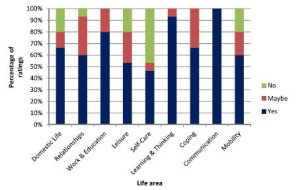
The researchers suggest that ‘These life areas can provide the ‘common language’ for team members to engage in dialogue and identify problem areas related to the daily life functioning of people with expressive aphasia. By simplifying some of the labels of the activities and participation dimensions of the WHO-ICF and pairing these labels with pictures and the interactive Talking Mats interview procedure, adults with expressive aphasia (who often have difficulty participating in the selection of rehabilitation priorities) were able to express their own views. This may be a first step in assisting the adult with aphasia to advocate for themselves and to exercise their right to identify the activities and participation opportunities which they would like to access, and to set rehabilitation priorities based on their choice. While the overlap in priorities among the three groups as found in this study is encouraging, the presence of some significant differences underlines the importance of the voice of adults with aphasia themselves. This ensures truly client-centred rehabilitation that underscores the principles of human rights and a focus on competence rather than deficits’.
To link to the full article: http://dx.doi.org/10.1080/10749357.2016.1207148aphasia
Please contact info@talkingmats if you would like to discuss using Talking Mats in research
Castle Hill High School has seen the benefits of using Talking Mats to let pupils have their say and be involved in planning outcomes. Jenna McCammon, Speech and Language Therapist & Rebecca Highton, Speech and Language Therapy Assistant, Stockport NHS Foundation Trust explain how they are using Talking Mats at Castle Hill High School.
Talking Mats has been beneficial in supporting young people with communication difficulties in school.
A Talking Mats approach has been used to support a pupil who presents with selective mutism. He started refusing to engage in lessons and activities, so school wanted to find out what he enjoys doing and how best to support him. Talking Mats allowed the speech and language therapy team to find out about his likes and dislikes at school, along with the reasons why he was refusing to engage in certain lessons. The sessions allowed the speech and language therapy assistant to build rapport with the pupil through finding out what he enjoys both in and outside of school, and the pupil communicated verbally during one of the sessions for the first time since his change in behaviour. The speech and language therapy assistant took pictures of the finished piece of work and asked permission from the pupil to share this with school staff. The speech and language therapy assistant was able to feed back the outcomes with staff and with other professionals during TAC meetings. Staff and other professionals would then request if the speech and language therapy assistant could obtain more information from the pupil, when needed, using Talking Mats.
Safeguarding – A possible safeguarding issue was suggested by a pupil during a therapy. The pupil has significant communication difficulties and so the information she was able to provide was very limited. The safeguarding officer in school requested if the speech and language therapy team could try to find out more. This was done us using Talking Mats, which allowed the pupil to share more information about the issue which was then shared with the safeguarding officer.
Motivational Interviewing is a tool used by the speech and language therapy team, both when assessing a new referral and when completing a review assessment in order to set new therapy targets. It is an opportunity for the young person to express their opinion, and can also be used to determine how much insight they have regarding their communication abilities. This is usually done verbally using a 10-point scale, however Talking Mats has been used by the speech and language therapist when assessing pupils with limited verbal ability. This allows these pupils to voice their views and have a say in their therapy planning. The findings from the Talking Mats motivational interviews then contribute to writing EHCP Reports for the pupil and are used to inform the decision-making process regarding their therapy goals.
Thanks to Jemma and Rebecca for sending these great examples. Change happens when we give young people a listening space.
 Online training login
Online training login 

